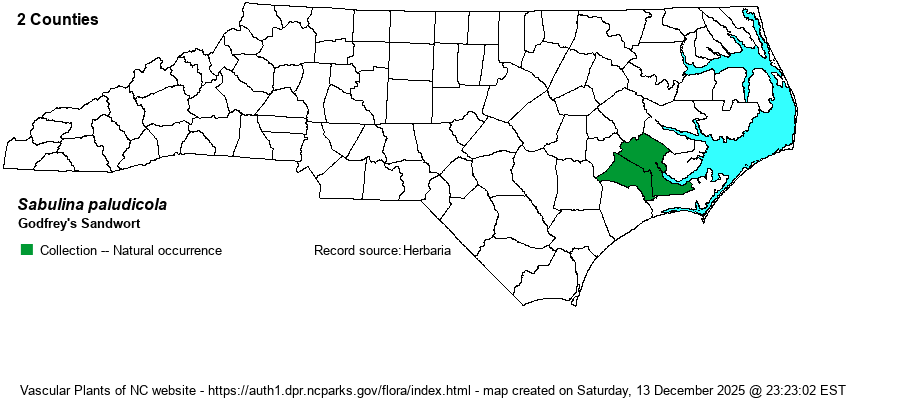| Author | (Fernald & B.G. Schubert) E.E. Schilling. | |
| Distribution | Limited to just two counties in the eastern Coastal Plain -- Craven and Jones.
This is a very rare species globally, limited to a few populations from west-central VA, eastern NC, and northeastern TN, south to parts of FL and AL. | |
| Abundance | Extremely rare, known from just three sites in close proximity in the Trent River and Island Creek areas just west of New Bern. Only one of the three known populations was considered extant around 2000, but all populations are considered by the NCNHP now as Historical (two) or Extirpated (one); however, they have not changed the State Rank from S1 to SH (Historical), which the website editors and Weakley's (2024) flora suggest. Surprisingly, this is not a Federally listed species, but it is State Endangered. | |
| Habitat | In NC, the species is limited to marl substrates, but in several habitats. It grows mainly on banks of tidal creeks and rivers, as well as into adjacent marshes; it also has been found in seepage areas in marl forests. | |
| Phenology | Blooms from April to June, and fruits shortly after flowering. | |
| Identification | This is a prostrate species, growing only to about 6-12 inches long. It has some branching and typically occurs in tangled mats or masses. It has opposite leaves that are linear and about 1-inch long. The flowers grow from leaf axils on fairly long pedicels, often about 1-inch long. Each flower has 5 white petals, with a spread of about 2/3-inch across. Somewhat similar, and growing in the same general area, is Arenaria lanuginosa, but that species grows in long trailing stems, not tangles in masses, and most leaves are more than 1/10-inch wide; most of its flowers lack petals. The only currently known site for M. paludicola is apparently reachable only by canoe and has not been checked in recent years, according to the NCNHP database, and thus more surveys in this region for that or new populations are greatly needed. | |
| Taxonomic Comments | This is one of a handful of species that were formerly in Arenaria, and then named as A. godfreyi. It was moved to Minuartia, was then moved to Mononeuria, with the specific epithet of paludicola. NatureServe still has it as Minuartia godfreyi. And now, in 2022, Schilling has moved it to still another genus -- Sabulina -- this is followed by Weakley (2022). What will it be named as next?!
| |
| Other Common Name(s) | Godfrey's Stitchwort | |
| State Rank | S1 [SH] | |
| Global Rank | G1 | |
| State Status | E | |
| US Status | | |
| USACE-agcp | | |
| USACE-emp | | |

